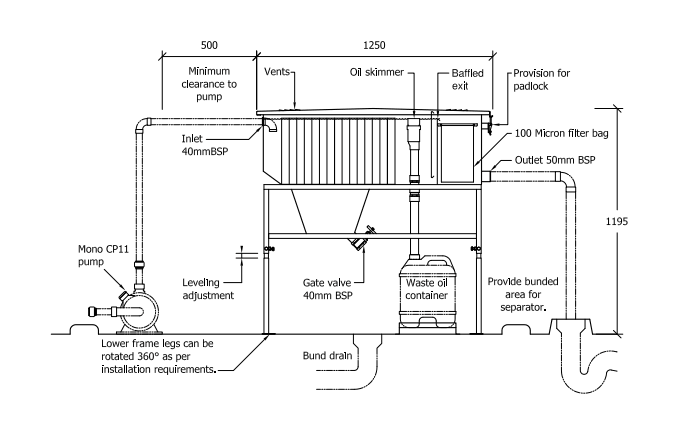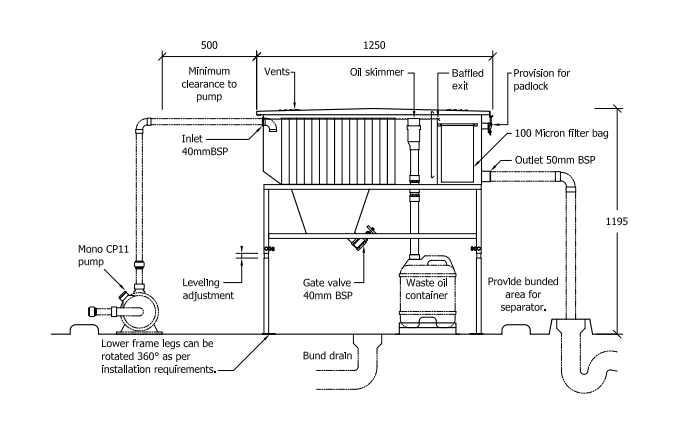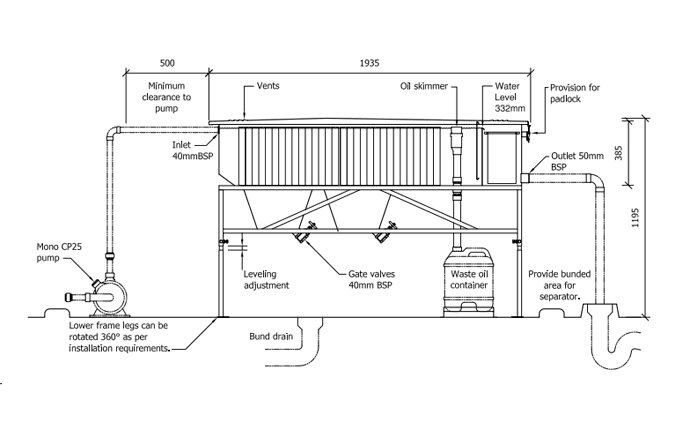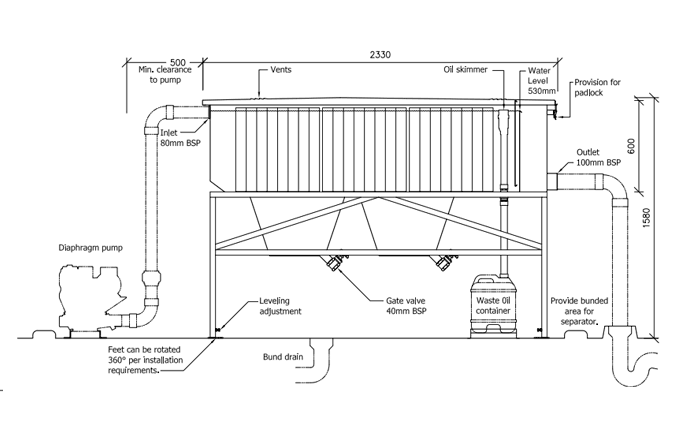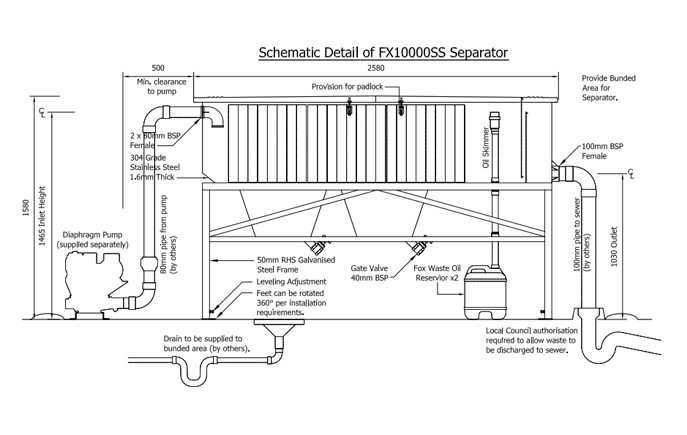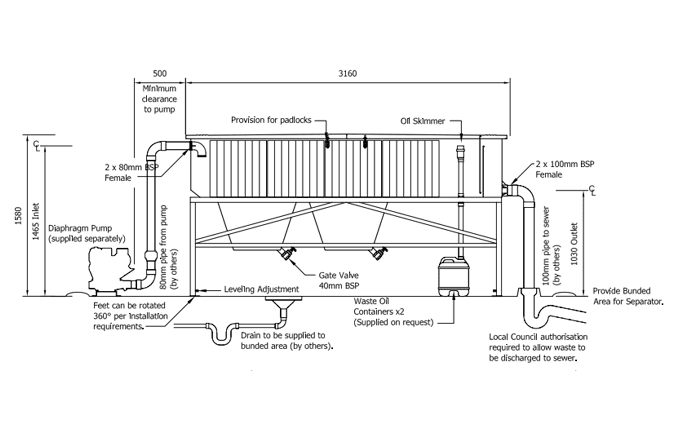Oil water separators
Oil water separator for wastewater treatment
Our range of oil water separator can efficiently treat wash down discharge, providing an effective solution for businesses that require wastewater treatment prior to the sewer network or water recycling systems.
What is an oil water separator?
An oil water separator is a piece of equipment used in wastewater treatment processes for separating oil and water mixtures into separate components. It is used to separate oils and solid substances such as gasoline, diesel, crude, vegetable oil and particulates as well as suspended solids that are heavier than water. In general, it is used in wastewater treatment systems to treat wastewater and remove contaminants before the wastewater is sent to the sewer.
How do they work?
The principle governing the operation of separators is quite simple. It works in eight main steps.
- The mixture containing wastewater and oil as well as suspended solids enters the system
- The heavier sludge flows out of the mixture and is captured in the sludge hopper
- The water and oily substances together with lighter particulates travel to the coalescing filters
- The mixture starts to separate in the coalescing filters and a portion of it (the mixture) moves up to the top of the separator while the remaining particulates flow down back to the sludge hopper
- The oil and water mixture from step 4 then travels through the coalescing filters and oil droplets (in the mixture) attach to the plates and combine together to form larger oil droplets
- Larger oil droplets from step 5 are released from the plates and travel to the top of the separator due to their sizes (combined pieces of small oil droplets)
- The oil level in the separator increases and reaches a certain level and passes through pipings and is stored in an oil storage tank
- The treated mixture moves to the water chamber where it goes through a final polishing pack and before being sent out to the sewer.
Do I need an oil water separator?
A company’s operating environmental aspects will determine whether or not an oil water separator is needed for managing its operation. If a company’s operation produces oil and wastewater, the company will be required to manage them sustainably in order for it to achieve compliance regulations. In general, environmental regulations require companies to ensure that unacceptable levels of contamination do not accompany wastewater being sent to the sewer network.
In the event that a company produces wastewater containing oil, the use of an oil water separator such as our Water Separators can help the company in question to protect the environment as well as save operating costs by removing oil and other contaminants from its wastewater mixture.

Do I need an oil water separator?
A company’s operating environmental aspects will determine whether or not an oil water separator is needed for managing its operation. If a company’s operation produces oil and wastewater, the company will be required to manage them sustainably in order for it to achieve compliance regulations. In general, environmental regulations require companies to ensure that unacceptable levels of contamination do not accompany wastewater being sent to the sewer network.
In the event that a company produces wastewater containing oil, the use of an oil water separator such as our Water Separators can help the company in question to protect the environment as well as save operating costs by removing oil and other contaminants from its wastewater mixture.


What advantages do they offer my business?
The industrial benefits of using oil water separators are social, economic and environmental in nature.
Environmentally speaking, the use of oil water separators helps to reduce oil pollution issues in industries. Also, it lessens the amount of wastewater produced from industrial operations.
Financially, the use of oil water separator helps companies to turn wastewater into a resource, which can be reutilised in their operations, thereby saving them operating and utility costs.
As mentioned earlier, the operating environmental aspects of a company will determine whether or not an oil water separator is needed for managing its waste. However, it is imperative to note that companies generally use it to save operating cost. For example, they can be used to remove suspended solids from wastewater and reduce waste recycling and pump out fees. In addition, the removal of suspended solids from process streams generally helps downstream equipment to function effectively and prevents them (system) from shutdowns.
What size do I need?
The size required will depend on the treatment flow rate and spill capacity of the wastewater mixture as well as applicable local and/or national regulations.
Flow Rate: In general, there are intermittent flow rates in industrial operations. The flow rate will determine the size of the separator. The size of the oil separator should be able to cater for flow rates projected from the contaminated flow of a company’s operation at any given time.
Regulations: Just like any other project, it is imperative for companies to check with local authorities within their areas to ensure that the size of their oil water separator systems meets local requirements, if any.
How much do they cost?
The cost of an oil water separator will depend on its size and design and this will be dependent on the flow rate and spill capacity of the wastewater (produced by a company) as well as regulations governing the area of the company’s operation.
Are there any ongoing costs associated with running one?
When purchased, there will be other operating costs for its installation and maintenance. A typical system should last between 20-30 years and maintenance routines are required for the system to work effectively. However, the cost of an oil water separator system makes up only part of the total installation costs.
How do I maintain them?
In general, they should be maintained regularly by draining and cleaning them of oils and debris as well as obstructive materials that can hinder the performance of the system. An authorised service technician should be used.
Summary
An Oil water separator is a good compliance tool for industrial companies producing wastewater. It helps companies to remove contaminants from wastewater before they are passed to the sewers. The size and design of an oil water separator system will depend on the process conditions applicable to the company’s operations as highlighted above.


